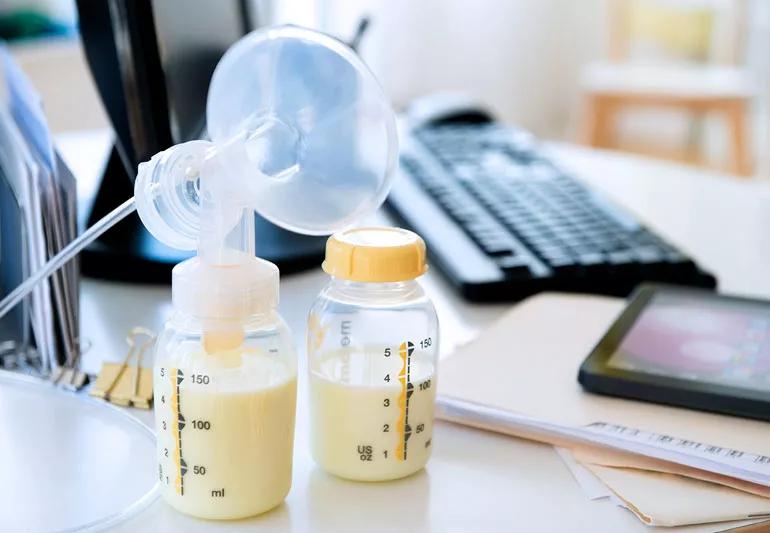Maintaining milk production starts with planning ahead

You’ve been feeding your baby breast milk and want to continue after you head back to your job following maternity leave. That just leaves one big question: How exactly will that work?
Advertisement
Cleveland Clinic is a non-profit academic medical center. Advertising on our site helps support our mission. We do not endorse non-Cleveland Clinic products or services. Policy
The answer to maintaining breastfeeding and pumping breast milk after returning to the workplace starts with planning, say lactation specialists Susan Buchanan, RN, and Marie Lattarulo, RN.
Here’s where to start.
Multitasking is often frowned upon these days, but pumping at work may qualify for an exemption.
The benefits of a double breast electric pump begin with time savings. It’s simple (and obvious) math, really: It takes 10 to 15 minutes to pump each breast, so doing both at once cuts the pumping time in half.
But this isn’t just a clock issue. It’s about productivity.
Stimulating both breasts to let down at the same time boosts the amount of milk expressed. (Some estimates put the increase at nearly 20%.) Also, the additional milk tends to be higher in energy-rich fat content for your child.
“A double breast pump is the most efficient way to pump at work,” says Lattarulo. “And there are advantages for you and your baby.”
It’s also easier (and more relaxing) if you use a hands-free pumping bra. That will allow you to multi-multitask and check work emails, text your childcare or scroll through your Instagram feed while pumping.
How often should you pump during the workday? That depends on how often your baby is fed at home. “Try to keep to the same basic schedule,” says Buchanan. “Do what your body is used to doing.”
Advertisement
Emptying out at your regular time also is key to maintaining milk output. If your body senses milk levels stuck on a FULL, it’ll naturally move to scale back production.
“A full breast that stays full is not a good thing,” notes Buchanan. “It needs to be emptied.”
Another tip? If you’re leaving your baby off at childcare, try to set your schedule so that you breastfeed your baby at drop-off and pick-up. That will help increase your one-on-one sessions with your child while minimizing pumping sessions at work.
Planning a feeding at the childcare site — if that’s an option available to you — also eliminates potential end-of-day delays due to commuting, meal making or other realities of life. “Plan to take the time right then,” says Buchanan. “It will help avoid complications later.”
Pumping your breasts at work may put you a bit ill at ease. It’s something you wouldn’t want to do in a location where you could be overheard or sitting in a bathroom stall worried about cleanliness.
The good news? You shouldn’t have to, thanks to federal regulations. The Fair Labor Standards Act requires businesses to provide a private space for nursing mothers to express milk. (A bathroom, even if private, is not a permitted location.)
Ideally, the space should include:
“It’s important to have a comfortable, quiet place to pump,” says Lattarulo. “The goal is to be in an environment that is as relaxing as possible. That’s when your milk production will be best.”
There’s nothing like holding your baby to get your milk flowing. The best option for that while at work? A little mental trickery. “Use your senses to fool your brain into thinking your baby is there,” says Buchanan.
Do this by:
“These serve as stimulations to help with milk flow,” notes Buchanan. “It’s a signal to the mind and body about what needs to be done.”
Creating a plan to minimize disruptions to breast milk production is important. Carrying it out effectively, however, is the ultimate goal, and that requires practice, say Buchanan and Lattarulo.
Advertisement
For instance, don’t wait until your first day back on the job to try your breast pump. “Use it a few times to become familiar with the equipment,” says Lattarulo.
Visit your workplace ahead of your return, too, to see the space you’ll use for pumping. (Plus, it’s always nice to show off your new bundle of joy to co-workers, who will no doubt coo and talk funny.)
Also, try to make a stop at your childcare facility to see if there’s a spot where you might be able to breastfeed your child coming and going.
“There is so much anxiousness and nervousness that comes with going back to work after having a baby, and that only increases when you add in breastfeeding,” says Buchanan. “A plan provides stability and a path to success.”
Advertisement
Learn more about our editorial process.
Advertisement

Breastfeeding moms can enjoy a drink — here’s how to do it safely

Study finds holding off is beneficial

Breastfeeding supplements can be a needless expense at best, and risky at worst

Typically, milk comes in a few days after birth and regulates around four weeks after delivery

A breast abscess can develop with or from mastitis

Type 2 diabetes isn’t inevitable with these dietary changes

Applying a hot or cold compress can help with pain